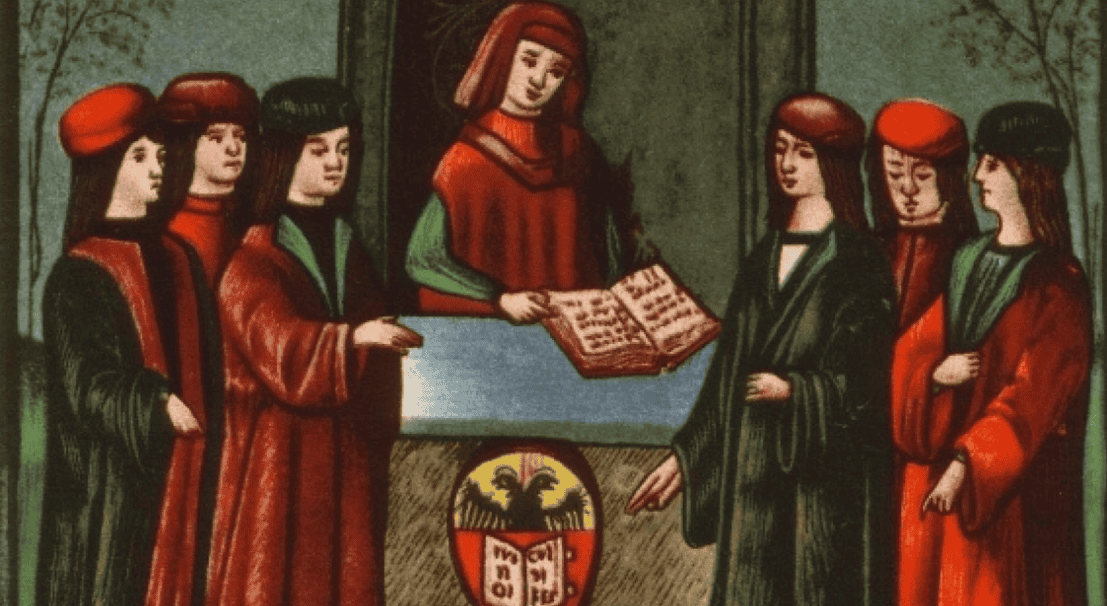Since the Middle Ages and throughout the early modern period, European universities and academies established dense webs of interpersonal connections among scholars. Using historical data on European scholars and their academic affiliations, this column argues that such networks were a key channel for the spread of knowledge across time and space. Especially without the dense networks offered by academies, where scholars could simultaneously hold multiple affiliations, ideas would spread only locally and fade. It was not the ideas themselves but the long-lasting institutions around them (or lack thereof) that made the difference.
It is often mentioned that the renowned Republic of Letters, the Europe-wide network of epistolary correspondences developed between the 17th and 18th centuries, established a transregional community of intellectuals (Roller 2023). However, well before the Republic of Letters took shape, universities and, later, academies had already laid the foundations for an even wider web of interpersonal connections among academic scholars.
But what did it mean to be a scholar in medieval and early modern times? In Europe, it likely entailed holding a teaching position at a university and possibly, some centuries later, being elected to become a member of an academy. Like today, colleagues at the same academic institution had natural opportunities to discuss what each of them was researching. Even before the printing press was invented or the postal system worked efficiently, these in-person academic communities provided a key channel for the spread of knowledge from one scholar to another, and from one institution to the next.
This early academic network was possible because scholars often travelled for teaching posts and frequently moved between universities. About 10% of the university scholars had more than one academic affiliation in their lifetime (de la Croix et al. 2024). Later, as academies gained traction in the early modern period, multiple affiliations became more common and could even be simultaneous. An intellectual might be invited to join an academy while still holding a university position, occasionally meeting fellow members at academy gatherings or staying in contact through institutional correspondence. All of this translated into an evolving affiliation network of scholars, where connections were formed simply by spending time at the same institution, particularly among those working in similar fields.
Now, if this were the only channel for knowledge to spread from the inception of the first medieval universities up until the end of the 18th century, would ideas travel far enough and survive? The answer could reveal how important these European academic institutions were, and it might partly explain the early intellectual lead of the West at the dawn of the Industrial Revolution.
In a recent paper, we attempt to assess this scenario quantitatively (de la Croix et al. 2025). Using micro-level data from the Repertorium Eruditorum Totius Europae project on scholars and their affiliations to European academic institutions, we build a dynamic network of academics based on their co-presence at the same universities or academies. Figure 1 presents two snapshots, for 1508 and 1730. Red nodes mark scholars in the giant component (the largest connected subnetwork); grey nodes are members of smaller components or isolates. In 1508 the landscape is archipelagic: small islands (e.g. single university communities) linked only when individuals move. By 1730, academies and their dense rosters of foreign members knit together a far larger share of the network, creating near-instant connectivity across institutions.
Figure 1 Snapshots of the affiliation network in 1508 (top) and 1730 (bottom)




Notes: Red nodes mark scholars in the giant component (the largest connected subnetwork); grey nodes are members of smaller components or isolates.
Next, we simulate the spread of ideas through this network. We ‘inject’ an idea into the network by assigning it to a single patient zero scholar (i.e. the initial inventor), then let it spread from one colleague to another as if it were an infectious disease (Banerjee et al. 2013, Koher et al. 2016, Fogli and Veldkamp 2021) without recovery. At any point, we can calculate an individual exposure metric, that is, the probability that any given academic would have heard about that idea from a colleague. Our approach does not assume the scholar endorsed the idea, but simply that they became aware of it. This is where channels like citation networks or letter correspondences would fall short: those capture only deliberate, usually positive engagement with ideas. In contrast, our affiliation-network approach records who was where and when, allowing us to infer who could have come into contact with particular ideas (under the simplifying assumption that shared institutional affiliation was the only means of knowledge circulation).
Ideally, we could model the spread of any innovation, paradigm, or theory developed by an academic between the 11th and the 18th centuries. We explore some, including an essential product of medieval universities, the Scholastic paradigm, as well as a scientifically falsifiable theory, namely, the belief that Sweden is Atlantis. But how can we verify whether our simulated ‘exposure’ to said ideas reflects historical reality? We cannot go back in time to ask scholars if, in a given year, they happened to have heard about a specific idea from a colleague. Not even analysing everything each academic wrote would suffice; someone might have been aware of an idea yet never written about it for various reasons.
However, we can strategically pick certain ideas that led to observable outcomes and check if our exposure metric correlates with those outcomes. We chose two such innovations: the creation of botanical gardens and the establishment of astronomical observatories at the city level. These essentially followed new paradigms in botany and astronomy emerging just before the Scientific Revolution (Appelbaum 2003). We label them ‘botanical realism’ and ‘mathematical astronomy’, respectively. The former was developed in 1542 by botanist Leonhart Fuchs (professor in Ingolstadt and Tübingen) in a revolutionary herbal featuring plants drawn from observation rather than from classical works. The latter coincides with the introduction of new methods for solving plane and spherical trigonometry problems, just before the heliocentric evolution, brought about in the year 1472 by the scholar Johannes Müller ‘Regiomontanus’, who taught in Bratislava, Padua, Rome, and Vienna over the course of his career.
For each of these two ideas, we simulate their spread over the affiliation network, one idea at a time. We compute each scholar’s simulated exposure to the idea, then aggregate those exposures up to the institution level and finally to the city level. If our exposure measure has real predictive power, cities with higher exposure to an idea should be more likely to implement that idea and thus establish a botanical garden or an astronomical observatory. Figure 2 illustrates the correlation for the case of botanic gardens.
Figure 2 Exposure to ‘botanic realism’ idea and cities with botanic gardens


Notes: Blue bubbles represent the exposure to the ‘botanical realism’ idea in 1793. Red diamonds are cities with botanic gardens; grey diamonds are cities without.
A resilient network across time and space
We find that even when assuming a relatively low transmission probability (for example, only a 25% chance that an idea passes from a previously exposed scholar to a colleague), our model still predicts a statistically significant relationship between a city’s exposure (via the affiliation network) and the historical adoption of the corresponding innovation. In other words, even though successful idea transmission was far from guaranteed, the affiliation network’s exposure metric is a significant predictor of these real-world outcomes.
Having established that this academic-affiliation channel mattered, what more can we say about its properties? How resilient was it to disruptions or missing pieces? We explore this via some counterfactual experiments, simulating the spread of ideas on modified versions of the scholars’ network. Our findings reveal that removing specific geographical regions (for example, hypothetically excluding all affiliations from a certain region) would not completely stop the spread or survival of ideas. Similarly, removing sub-communities like the Jesuits (known for their prominent scientific contributions) does not break the network’s ability to disseminate ideas.
However, one result is striking: if we only had the universities (characterised by mostly single sequential affiliations per scholar), ideas would spread locally but eventually die out. By contrast, the rise of academies, and with them, scholars holding multiple affiliations simultaneously, appears crucial to sustaining long-term knowledge dissemination. Without academies, the chain of knowledge transmission would have been much more fragile. Figure 3 illustrates this point: in a hypothetical scenario without academies, the largest connected component of the network in 1730 is significantly smaller. The figure replicates the 1730 snapshot shown in Figure 1 but with a substantial fraction of edges removed: specifically, those generated by co-affiliation to academies.
Figure 3 Snapshots of the affiliation network in 1730, in the hypothetical scenario without academies


Lessons for today: The power of connections
No matter how good an idea is on its own, it often needs the right context to succeed. Throughout history, good ideas emerged across all regions, yet only some persisted. In Europe, many ideas survived because they were embedded in dense institutional networks – universities, academies, and scholarly communities. Elsewhere, the absence of comparable structures often meant that knowledge remained fragile and easily lost, as with ancient India’s corporate bodies (śreṇī) or the Andean quipu system. It was not the ideas themselves but the long-lasting institutions around them (or lack thereof) that made the difference. If universities lose funding or autonomy, their ability to preserve and transmit knowledge weakens; if international research collaborations collapse under the weight of geopolitics and ideological gaps, ideas risk becoming trapped within national borders (de la Croix and Morault 2024).
History shows that societies thrive when they invest in strong, connected institutions of knowledge. The lone genius is often celebrated – Condorcet, Euler, Ockham (just to name a few premodern scholars any economist should recognise) – but their contributions depended on academic networks. In the past, Europe’s universities and academies provided that infrastructure. Today, it takes the form of universities, research institutes, and international organisations like CEPR or NBER. They are our collective ‘knowledge infrastructure’. The lesson is simple but powerful: bet less on isolated breakthroughs and more on building resilient institutions that let ideas circulate.
Source : VOXeu





